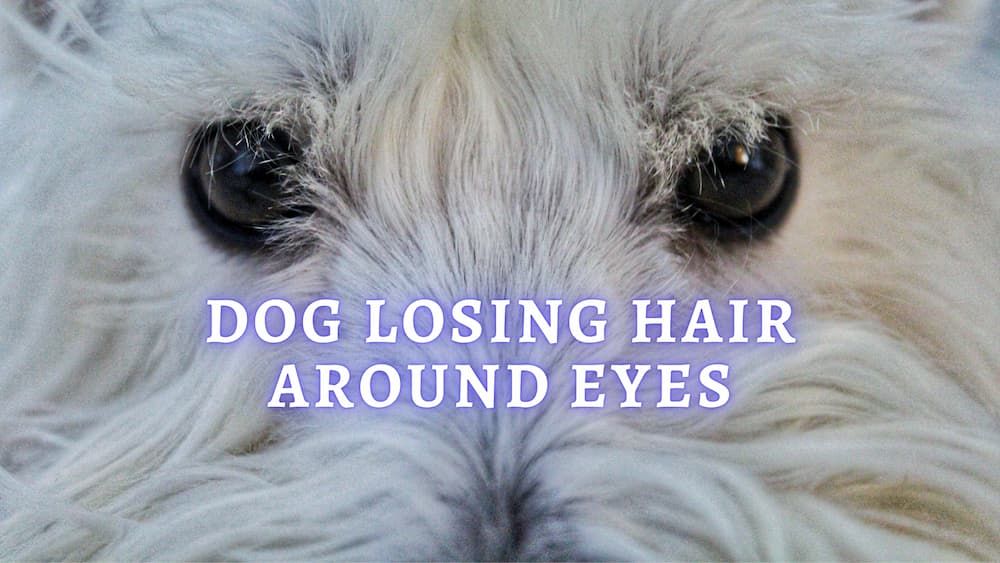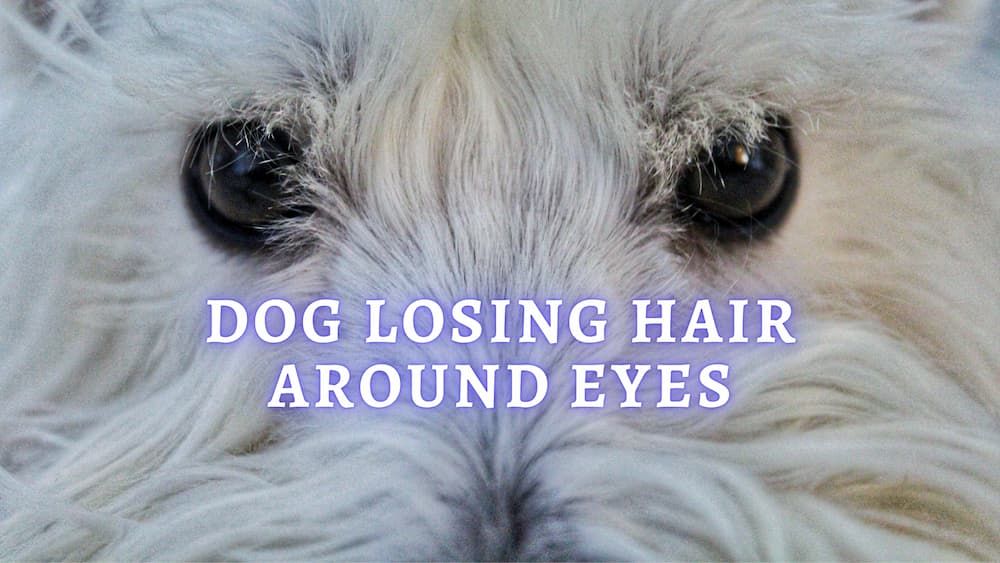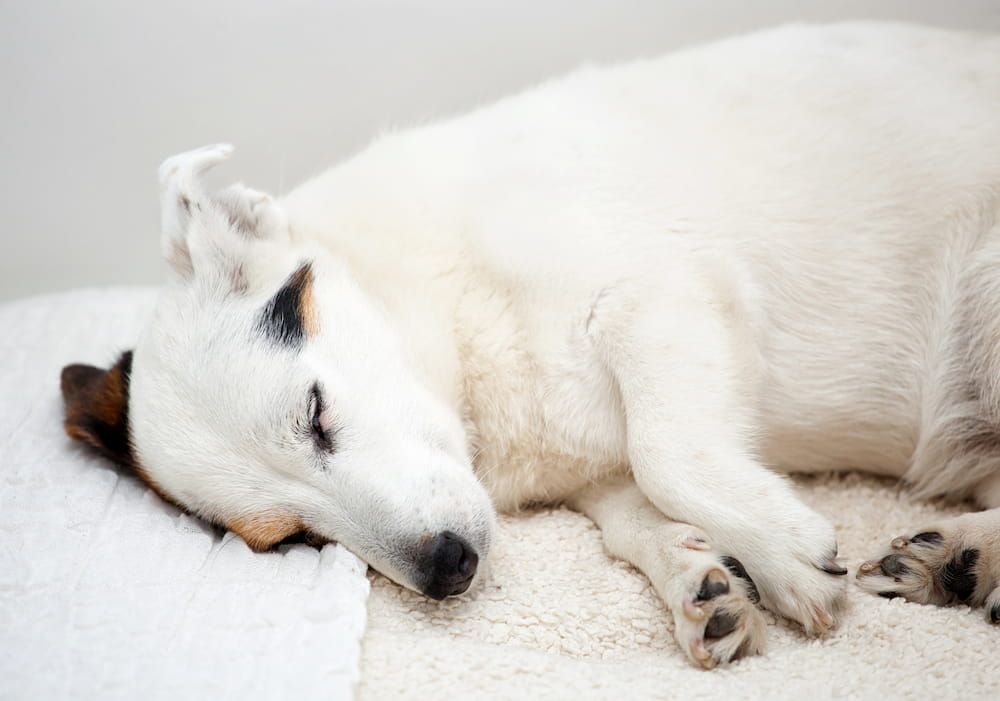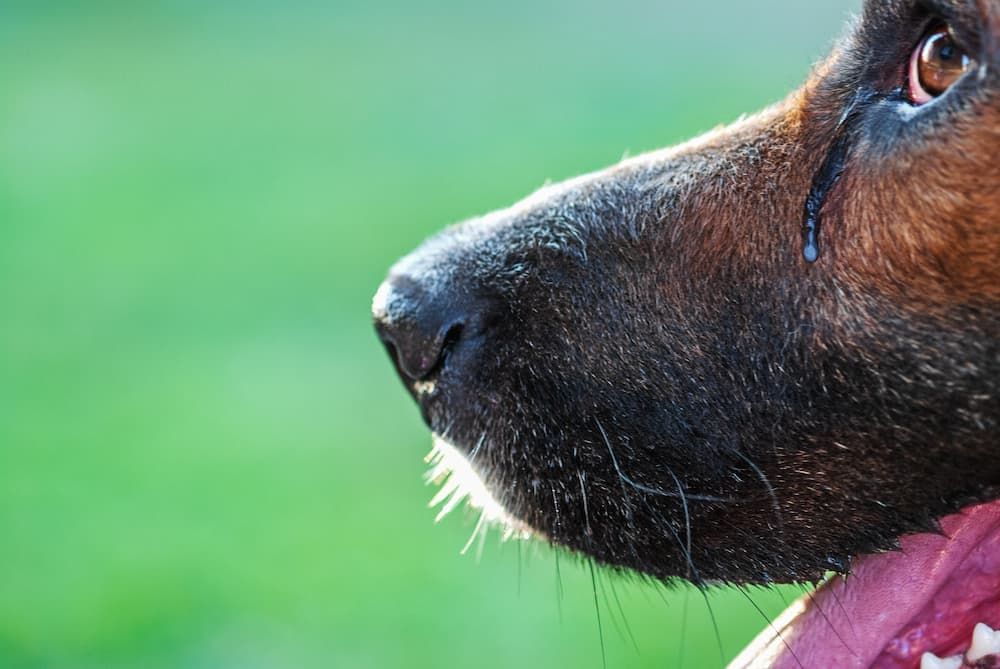
It may not come as a surprise to you that dogs losing hair is often a regular occurrence. Sometimes this is year-round, and sometimes seasonal hair loss, and in many cases, it is perfectly normal. However, if your dog is beginning to lose hair in patches and is developing bald areas on your dog’s skin, this may be a cause for concern.
Balding because of hair loss is known as alopecia, and not only can it be unsightly, but it can also be a cause for concern for dog lovers. It can be in a focal area, extensive, random, or symmetrical. The pattern observed (or lack thereof) often gives a clue to what is causing it.
One pattern which warrants veterinary attention is dog hair loss around the eyes, also known as periocular alopecia. This is rarely normal; however, the good news is that you can treat it. This article will discuss the causes of hair loss around the eyes in dogs and the diagnosis and treatment of hair loss.


Photo by Kaylin Bocker on Unsplash
Possible Causes of Hair Loss Around Eyes
Periocular alopecia in dogs usually occurs following trauma or inflammation to the hair follicles or skin around your dog’s eye. This might be primarily caused by a disease affecting that area, or secondary to rubbing their eyes on furniture or carpet to relieve their discomfort. Therefore, there are many potential causes of hair loss in this region, and it will require the help of your vet to narrow down the cause.
Demodicosis
Demodicosis is a condition caused by Demodex mites and is also known as demodectic mange. It is one of the most common primary conditions which causes fur loss around the eyes.
Demodex mites like to live in the hair follicles, and they are generally not considered contagious to other pets. While they don’t usually cause any symptoms, their presence may lead to hairless patches if your dog has a weakened immune system. These patches might be in a focal area, such as around the eyes or on the toes, or generalized over a larger body area. Approximately 90% of localized demodicosis cases resolve spontaneously; however, 10% may become generalized and require more intensive veterinary treatment. [1]
Demodectic mange is almost exclusively a condition of young dogs under one year old. As your dog matures, so does his immune system, however, treatment is usually given to facilitate recovery. Suppose your dog is older and has developed demodicosis. In that case, this is usually an indication of a more serious underlying condition, such as cancer, liver, or kidney disease, and therefore warrants further investigation.
Allergies
Your dog’s allergies could be caused by environmental allergies, food allergies, contact allergies or serious allergic reactions from bites or stings. All of these can cause hair loss due to excessive scratching, biting, or licking in response to a feeling of itchiness. The typical areas affected include under the armpits, belly, groin, flanks, ears, and paws, but the whole body can be afflicted, including the face and around the eyes.
An environmental allergy can also lead to hayfever-like symptoms. These can result in itchy, watery eyes, which your dog may try to relieve by rubbing their face on objects. Due to this friction, the hair may start to fall out.
If left uncontrolled, allergies can cause significant discomfort and lead to secondary skin infections, such as yeast infections. Therefore, it’s essential to work alongside your vet to determine what is causing your dog’s allergies and treat or avoid the underlying problem.
It’s also important to note that allergic reactions require urgent veterinary attention, and so if you think your dog has been stung by a bee or similar and is swollen around the eyes, immediately take him to your local vet.
READ MORE: Dog Seasonal Allergies
Eye injury
Any cause of eye pain can lead to your dog rubbing his eyes against the furniture. The outer layer of the eye, known as the cornea, has one of the densest networks of nerves in the body, which results in it being extremely sensitive. [2] Therefore, any sort of trauma to the eye can lead to the extreme pain, causing squinting and excessive blinking.
Eye trauma can result from a foreign body becoming stuck in the eye or an eye injury from a laceration from a stick or claw. Regardless of the cause, pet owners should take their dog to the vet immediately if you suspect your dog has an eye injury, as in severe cases, the eye could rupture if left untreated.
Glaucoma
Another cause of eye pain, which can cause your dog to rub his eyes, is glaucoma. Glaucoma is a build-up of pressure within the eye, which usually has an underlying cause that your vet should investigate.
It usually causes symptoms such as a clouding of the eye; however, the first sign is usually a discomfort. There is veterinary medicine available to treat glaucoma as well as underlying issues but left untreated; it could eventually lead to your dog requiring removal of their eye.
Conjunctivitis
Conjunctivitis, also known as pink eye, is a condition where the inner part of your dog’s eyelids, known as the conjunctiva, becomes inflamed. Conjunctivitis is usually caused by bacterial infections and can lead to your dog’s eye becoming pink and sore, as well as producing a green discharge.
While an eye infection is another reason your dog rubs their eyes, resulting in irritated skin and baldness, the discharge may also lead to a skin infection that can damage the follicles and cause hair loss.
It’s important for pet owners to wash their hands before and after touching an infected eye, as some bacteria can also cause pink eye in people too.


Photo by @antoniogravante from Freepik
Dry eye
Similar to conjunctivitis, dry eye can also cause a mucus discharge from the eye, which in turn causes irritation and secondary skin infection.
Dry eye, also known as keratoconjunctivitis sicca or KCS, is a condition that prevents your dog’s eyes from producing the watery component of tears, resulting in the eyes becoming dry, itchy and mucusy. Therefore, it is another cause of discomfort and may result in rubbing and hair loss secondarily too.
Tear overflow
If your dog suffers from tear overflow, the constant moisture on the skin may cause secondary bacterial skin infections and hair loss, as well as orange tear staining down the side of the nose.
Tear overflow is a common problem, particularly in breeds prone to constant ocular irritation. For example, brachycephalic (short-nosed) breeds often have bulging eyes, which are more exposed to the elements than other breeds, making them more irritated and waterier. Also, dog breeds with long hair around their faces may find the hair recurrently touches their eyes. This is one reason dog owners may tie up their dog’s hair on the top of their head, or regularly get their dogs groomed.
Nevertheless, tear overflow may also be an indication of a problem and require veterinary treatment. Blocked tear ducts and ectopic cilia (hair growing out the eyelids in the wrong place) can also result in tears overflowing out the eye.


Photo from Freepik
Parasite
Parasites on your dog’s body can lead to intense itching and discomfort. Fleas and ticks particularly like residing around the ears resulting in constant scratching of that area. Since the eyes are particularly close, trauma can result in hair loss on the face and ears, as well as near the eyes.
Your dog does not necessarily need a flea infestation to experience itching from fleas. Many dogs have flea allergies, which results in an allergic reaction in the skin from just one flea bite. However, it’s important to remember that even if your dog only has one flea on their body, there will be 20 times more in the environment. Therefore, monthly parasite preventative treatments, and regularly treating the environment is important to keep on top of any infections.
Other causes hairless patches
There are many other causes of hair loss, including fungal skin infection, such as ringworm, extreme stress, weather changes, and endocrine diseases, such as Cushing’s disease and hypothyroidism. However, these conditions can cause your dog’s coat to suffer from bald spots anywhere on the body and not necessarily just the hair around the eyes. Nevertheless, your veterinarian is likely to keep them in mind when investigating why your dog is losing hair around the eyes.
When Should You Worry About Fur Loss Around Your Dog’s Eye?
While fur loss on the body can be normal, you should contact your veterinarian if you notice it around your dog’s eye, particularly if your dog’s skin is also inflamed. Common symptoms which are associated with hair loss in that region are eye pain, skin irritation, excessive tears or eye discharge, tear staining and observing your dog rubbing or scratching the area.
Therefore, if you notice any of these other symptoms, it’s a good idea to seek veterinary advice so that the underlying condition can be addressed, and your furry friend can become more comfortable again.
How To Diagnose Your Dog Losing Hair Around Eyes?
You should ask your veterinarian for advice on treating your dog’s hair loss around the eyes. He is likely to start by asking you when you first noticed the hair loss, and if you’ve noticed any other symptoms, such as constant scratching, discharge, or signs of eye pain, such as squinting or blinking. This will be followed by a close physical examination of the area, including the skin, the eye and any other areas of your dog’s fur which may also be affected. A full physical examination, including looking at your dog’s mucous membranes, listening to their heart and lungs, palpating their abdomen, and checking for enlarged lymph nodes could also be required.
Your vet may then do further skin examinations, such as a skin scrape or tape impression smear, and look at them under the microscope, as well as further eye examinations, such as staining the eye, and examining it with an ophthalmoscope.
There are many potential treatments for bald areas around the eye as there are many different causes. Food allergies may require a food elimination diet, environmental allergies may require allergy shots or oral medications, skin infections may require a topical veterinary medication, a fungal infection may require oral antifungal medications, eye injuries may need eye drops, and your pet’s coat may require a medicated shampoo if it’s affected in other areas too. It is best to talk to your veterinarian rather than treat at home, as they will be able to determine the most suitable treatment for your canine companion.


Photo by Kat Smith from Pexels
Read More Veterinarian Tips on Dog’s Health
FAQ
Why is my dog losing hair around his eyes?
There are numerous different reasons why your dog may lose hair around his eyes. It may be a primary condition affecting the skin, or it may be secondary to self-trauma from trying to relieve discomfort associated with the eye. Only a veterinarian can do the appropriate tests and determine the underlying cause.
My dog loses hair around the eyes – could it be a mineral deficiency?
In farm animals, mineral deficiencies in copper, zinc or selenium can lead to fur changes or hair loss around the eyes. However, this is unlikely to occur around your dog’s eyes as it is not a condition that commonly affects dogs.
Can dogs losing hair around the eyes be reversed?
Fur loss can be reversed if the follicles are not damaged, which usually only occurs if there is scarring. This means that fur loss can usually be reversed if the underlying disease is addressed.
How can I treat my dog’s hair loss?
There are many different treatments for hair loss and the cause must be treated directly to restore the hair to normal. As a result, treatments differ from dog to dog, and you should follow your vet’s guidance.
Is my dog’s skin sore?
Skin inflammation can create bald spots due to the follicles of the hair becoming damaged. In this case, the skin is usually sore. However, if hair loss is due to trauma from rubbing or scratching, the hair shaft itself is usually what has been broken and therefore, the underlying skin is not always uncomfortable.
{"@context":"https://schema.org","@type":"FAQPage","mainEntity":[{"@type":"Question","name":"Why is my dog losing hair around his eyes?","acceptedAnswer":{"@type":"Answer","text":"There are numerous different reasons why your dog may lose hair around his eyes. It may be a primary condition affecting the skin, or it may be secondary to self-trauma from trying to relieve discomfort associated with the eye. Only a veterinarian can do the appropriate tests and determine the underlying cause."}},{"@type":"Question","name":"My dog loses hair around the eyes \u2013 could it be a mineral deficiency?","acceptedAnswer":{"@type":"Answer","text":"In farm animals, mineral deficiencies in copper, zinc or selenium can lead to fur changes or hair loss around the eyes. However, this is unlikely to occur around your dog\u2019s eyes as it is not a condition that commonly affects dogs."}},{"@type":"Question","name":"Can dogs losing hair around the eyes be reversed?","acceptedAnswer":{"@type":"Answer","text":"Fur loss can be reversed if the follicles are not damaged, which usually only occurs if there is scarring. This means that fur loss can usually be reversed if the underlying disease is addressed."}},{"@type":"Question","name":"How can I treat my dog\u2019s hair loss?","acceptedAnswer":{"@type":"Answer","text":"There are many different treatments for hair loss and the cause must be treated directly to restore the hair to normal. As a result, treatments differ from dog to dog, and you should follow your vet\u2019s guidance."}},{"@type":"Question","name":"Is my dog\u2019s skin sore?","acceptedAnswer":{"@type":"Answer","text":"Skin inflammation can create bald spots due to the follicles of the hair becoming damaged. In this case, the skin is usually sore. However, if hair loss is due to trauma from rubbing or scratching, the hair shaft itself is usually what has been broken and therefore, the underlying skin is not always uncomfortable."}}]}
Article Sources:
- “Demodectic mange in dogs”, VIN Veterinary Partner, veterinarypartner.vin.com/default.aspx?pid=19239&id=4951505.
- Yang, Alina; Chow, Jessica; Liu, Ji. “Corneal Innervation and Sensation: The Eye and Beyond”. 28 March 2018. PubMed. pubmed.ncbi.nlm.nih.gov/29599653/.








